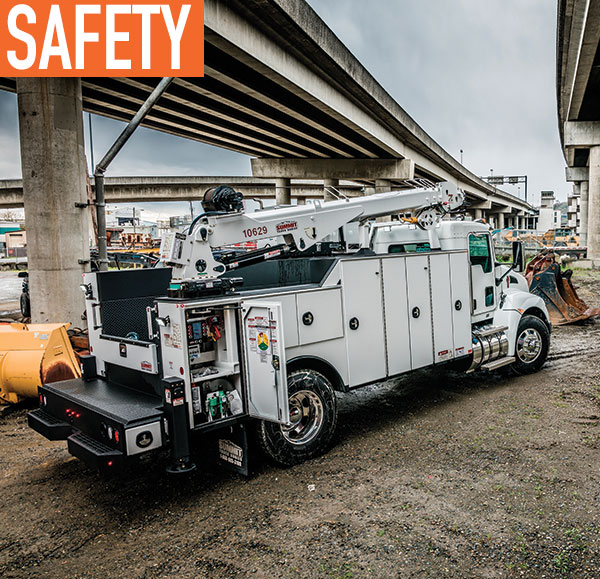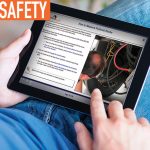If your company employs cranes on a daily or even weekly basis, you’re well aware of the problems that can arise from their use. If a service crane isn’t operated or maintained properly, it could cause injury or even death to employees and damage to equipment, costing a fortune.
PROBLEM
Ideally, your company would always dock a crane in a leveled, paved area and away from traffic and the public. Yet that isn’t always the case—it’s hardly ever the case, actually. Your crew must go where the job is, and sometimes that’s up rocky hills, over dirt, and through forests. Ensuring a level crane then becomes a trying aspect of the job, and operating a crane on uneven ground is never safe.
To solve your problem of uneven ground, you use outriggers—a safe option. But what about those moments when the ground is just level enough to operate the crane? Your crew might think operating a crane without outriggers would be the most efficient option, but they would be wrong. In the event that outriggers are not used or improperly used opens up a whole set of risk factors in which you don’t want your crew involved.
SOLUTION
The use of new electronics safety technology in a fully integrated crane safety system can protect technicians, equipment, and loads from hazards that may arise on any ordinary work day. A safety system can eliminate the guesswork and simplify a decision to use a crane in certain conditions or if your truck and crane can handle a load.
When uneven ground conditions make it unsafe to operate a crane, an integrated crane safety system using outrigger sensors signals when the truck is not level and prevents crane operation. Technicians can adjust the outriggers to make sure the truck is stable before lifting with the crane.
A crane safety system is perfect for those instances when a crew might think it’s safe enough to use a crane without outriggers. These outrigger sensors detect proper deployment of the outriggers and prevent technicians from using the crane until the outriggers are properly deployed—ensuring safe working conditions and a safer crew.
MORE PROBLEMS
How heavily you load your crane can have a huge impact on its performance, both currently and long-term. It is important to know exactly how much weight is loaded onto the crane. You’ll surely run into problems if you don’t know the exact or even approximate weight of your load.
When loading your truck or crane, it is imperative to abide by weight restrictions of the vehicle or the crane. Overloading a crane can lead to structural failures and upsets. Exceeding a crane’s operational capacity subjects the crane to structural stresses and can cause irreversible damage. Operators may overload a crane if they swing or suddenly drop loads, lift loads beyond the crane’s maximum capacity, side load, or drag loads.
MORE SOLUTIONS
Electronics systems can tell you the weight of a load, angle, and reach of the crane used in real time. This provides crane operators the information they need to make the right loading decisions.
Many manufacturers offer an overload prevention system that helps operators avoid getting loads in dangerous positions that exceed the capacity of the crane. One such manufacturer is Summit Truck Bodies.
SUMMIT SOLUTION
In each of these problematic scenarios, Summit Truck Bodies’ Advanced Safety Electronics (ASE) system is prepared to get your workers through the day, safely and efficiently.
If you’re working on uneven ground, Summit’s fully integrated safety controls system features auto outrigger deploy and leveling. Outrigger interlocks progressively limit crane operation if outriggers are not in the correct position.
Don’t stress about the weight of your load. Summit Truck Bodies offers real-time data on an LMI (Load Moment Indicator) screen located on both the remote and main control panel, so technicians can operate the crane safely and make the best decisions when it comes to load handling. The operator can see the current weight, reach, angle, and capacity of the load through Summit’s ASE.
Perhaps the most helpful aspects of Summit’s ASE system are the sensors on the crane that trigger the system to slow crane operation if a load reaches 80% capacity. If the operator allows the crane to reach maximum capacity, the safety system will not allow any load movement that further exceeds the crane’s limit; however, it does allow them to reposition the crane safely. During times of exceeded capacity, the rumble pack in the handheld remote vibrates, alerting the operator that the maximum crane capacity is reached. This is especially helpful for crane owners concerned about the wear and tear on their equipment. Proper use of a crane lengthens the life of the crane.
When it comes to keeping your equipment and, most importantly, your crew safe, you can’t go wrong with a Summit Truck Bodies’ Advanced Safety Electronics system.
FOR MORE INFORMATION:
Find out more about Summit’s ASE, visit www.summitbodies.com.
MODERN WORKTRUCK SOLUTIONS: JULY 2018 ISSUE
Did you enjoy this article?
Subscribe to the FREE Digital Edition of Modern WorkTruck Solutions magazine.
![]()






